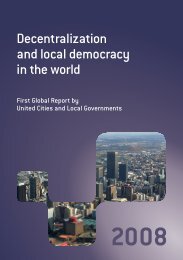Making Cities Resilient Report 2012
Making Cities Resilient Report 2012
Making Cities Resilient Report 2012
You also want an ePaper? Increase the reach of your titles
YUMPU automatically turns print PDFs into web optimized ePapers that Google loves.
Mass awareness campaigns<br />
Mass public awareness campaigns are encouraging changes in household-level behaviours toward risk<br />
reduction and ensuring that early warnings are acted upon. Some campaigns are conducted annually,<br />
such as cyclone awareness campaign in Cairns (46). Other cities focus on a particular hazard facing the<br />
city. These include Bangkok’s flooding campaign (43); Cape Town’s urban sustainability ‘Smart Living<br />
Campaign’ (33); and Overstrand’s water conservation awareness effort to reduce the risk of drought (21).<br />
Many campaigns use a combination of print, audio, and online materials to disseminate information.<br />
Saijo City distributes hazard booklets to government bodies, public halls and libraries (48); Makati airs a<br />
disaster risk reduction radio programme (31); Makassar has a disaster risk management website (38); and<br />
Bhubaneswar publishes a newsletter. Some cities also offer incentives to encourage public engagement<br />
in risk response. For example, the St John’s Ambulance Service in Kisumu runs a local first aid competition<br />
that feeds into regional and national-level competitions (40).<br />
Several cities use national or global disaster risk reduction events to heighten public engagement. For<br />
example, both South Africa and the Philippines celebrate World Disaster Reduction each year, while Nepal<br />
and Japan both observe the annual anniversary of a significant national disaster.<br />
Box 4.10 : Public awareness and education in Bhubaneswar, India<br />
[Essentials 5, 7]<br />
The city of Bhubaneswar began working on disaster risk reduction in 2003 with an urban risk assessment to<br />
identify priority risk areas. Early on they recognised the challenge of low-level public awareness of disaster<br />
risk reduction, which extended to staff in the disaster management department.<br />
Public awareness: Extensive mass awareness campaigns and formal training courses have included<br />
training for doctors (mass casualty management); community health workers (first aid); engineers,<br />
architects and planners (earthquake vulnerability and rapid visual screening to identify the earthquakeresistant<br />
capacity of structures); masons (earthquake-resistant construction); and women from self-help<br />
groups (urban risk reduction). Training courses for volunteers have focused on emergency response,<br />
including search and rescue, first aid, relief management, water and sanitation, damage assessment,<br />
and debris management. Community risk assessments have been conducted to increase community<br />
engagement and awareness and capture ground-level information on risks.<br />
Trainings in schools: Disaster preparedness and response has been introduced into the curriculum at<br />
primary, secondary and university level, including training teachers in school disaster management<br />
and planning, training school-based disaster management teams in search and rescue and first aid,<br />
preparation of school safety plans, and awareness activities for students. To date, 3,000 students have<br />
been educated in disaster risk management planning and safety tips, and a school safety programme has<br />
been implemented in 35 schools. Mock drills have been held at city, ward, and community levels as well<br />
as in schools and colleges, involving ODRAF, the State Fire Service, the National Disaster Response Force<br />
(NDRF) and community volunteers.<br />
Building political will through education – and through local champions among city workers, planners<br />
and engineers. This has played a significant role in building political will, momentum and a culture of<br />
commitment to disaster risk reduction. Key to this has been the education of local government officials<br />
about urban risk management issues. Bhubaneswar was the first municipality in the state of Orissa to<br />
sign on to the Campaign in 2010, and its leadership position has been confirmed by the large number of<br />
municipalities who later signed up at a 2011 Campaign event, committing to amend construction bylaws,<br />
raise awareness and improve school and hospital safety.<br />
58 | <strong>Making</strong> <strong>Cities</strong> <strong>Resilient</strong> <strong>Report</strong> <strong>2012</strong>

















